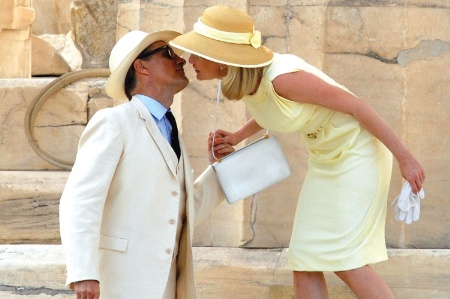Source: Rex Features
The Two Faces of January
Directed by Hossein Amini
Starring Viggo Mortensen, Kirsten Dunst and Oscar Isaac
On general release in the UK from 16 May 2014
The film makes something powerful and explicit from the ideas about sexuality that Highsmith implicitly recognised but did not develop
In film as in literature and myth, triadic relationships provide lasting material. This emerges very clearly from Iranianborn director Hossein Amini’s version of Patricia Highsmith’s novel The Two Faces of January, first published in 1964. Set largely in Crete and mainland Greece, this tells the story of a middle-aged conman, Chester MacFarland (played in the film by Viggo Mortensen), and his young wife Colette (Kirsten Dunst), who meet a young American called Rydal Keener (Oscar Isaac).
Keener is waiting for what he describes to himself in the book as an “Adventure” and, when “Adventure” arrives, it is through his involvement in the lives of Mr and Mrs MacFarland. While staying at a hotel in Athens, Chester shoots a private detective sent to challenge his decidedly dubious financial affairs, in which he has sold shares for non-existent companies. Rydal, who happens to be in the wrong place at the wrong time (although the right place, for the purposes of the story), helps Chester hide the body. He is then drawn into further deceit, complicated by his growing attraction to the young Colette. The film does not end happily.
Highsmith based the character of Chester MacFarland on a real middle-aged man she had encountered on a trip to Greece in 1960. The trip had not been a sunny journey around the great sites of antiquity; on the contrary, she wrote in her diaries of “musty” hotels and her dislike of Athens. It was perhaps this which gave the novel the “very unhealthy air” that the reader at Highsmith’s usual publisher remarked upon, a judgement that endorsed its rejection. They also said: “There is a frightening sense of the neurotic about the author’s approach to and conception of character. There is no reason or motivation for their actions.”
This implicit dismissal of two of the great themes of literature, sex and money, was also to be found in many of the reviews in the United States, which implicitly repeated the criticism of “unhealthiness”. Yet Brigid Brophy wrote that Highsmith had continued the work of Dickens and “made the crime story literature”. Other English critics reviewed the novel equally favourably. Clearly, the “unhealthy” had a greater appeal on the European side of the Atlantic; indeed, the book won the Crime Writers of England Silver Dagger Award for the best foreign crime novel of 1964.
Since the film is set at roughly the time Highsmith’s novel was published, Crete and much of the rest of Greece have not yet achieved the greater glossiness of the present. Communications are still limited, Knossos largely empty of tourists. It is in this world that the threesome of Chester, Rydal and Colette set off on their tortuous journey to avoid arrest and capture, a journey that involves growing physical discomfort and emotional tension. The three are primarily locked together by murder and complicity in murder, but their relationship is increasingly complicated by the alliance between Colette and Rydal, and the dependence of Colette and Chester on Rydal’s fluency in Greek and access to those willing to forge passports. “Unhealthy” does not quite cover the various forms of danger, hatred, dependence and sexual jealousy.

As is often the case with group outings to great historical sites, things do not go well and at Knossos, Colette is killed in an accident. The two men are now alone, pursued by the police and, even when they separate, still bound together by chains of revenge and fear. There can be no real separation for this pair, fugitives from both their immediate crimes and aspects of their pasts. Rydal has fled his controlling father, Chester another version of the patriarchal order, the law. When Highsmith wrote about the novel, she said that she wished to examine the “irrational” and the fantasies that the characters have about one another. Among these fantasies (and perhaps part of the reason for the novel’s critical reception in the United States) is the attraction not just between Colette and Rydal but between Rydal and Chester, although this is much more apparent in the film than in the book. Indeed, the screen is dominated by the male characters, a form of bonding that is at first uneasy friendship, then distrustful cooperation and finally outright hatred. Colette’s part in this, until her death, is to secure an uneasy truce between them, a truce that allows her to develop her own romance with Rydal.
In various ways the film sharpens the narrative of the book (by providing, for example, a believable reason for Rydal’s appearance at the time of the murder). But, more than that, it makes something powerful and explicit from the ideas about sexuality that Highsmith implicitly recognised but did not develop. The film allows the characters to bring out those “neurotic” aspects of human character that so frightened her critics: most obviously, the possibility of male homosexuality but, more than that, the complexity of all sexuality, endlessly impossible to organise into neat categories of man and woman, husband and wife. At least in the book, Rydal has had something of a dubious sexual past (a relationship with an underage girl), but through the fantasies that Chester’s physical resemblance to his father conjure up he begins to desire Colette, now recreated as a possession of his father that he has to gain.
Colette’s role in these conjunctures is both to encourage and to discourage Rydal. She endorses his presence with herself and Chester, then begins more obviously to take his side in arguments as their journeys (and living standards) become more bleak. But at no time does she explicitly abandon Chester or become actively critical of the situation they find themselves in. Indeed, in the moments just before the accident that kills her, she is positively cheerful and interested in the palace at Knossos, while Chester and Rydal are preoccupied with remaining close to Colette.
After her death the two men fight, separate and are finally brought together in a redemptive moment. One of them is saved, and returned to conventional life, the other dies. But the film – which, like the book, has few characters and a simple plot – brings out the timelessness of Highsmith’s novel. This makes it very enjoyable to watch but also poses questions about the ways in which the “normal” can have such a stranglehold on the limits of the imagination. In 2014, the various forms that sexual desire can take are a subject of public discussion; even those who adopt a rigid approach to such issues seldom fall back on terms such as “unhealthy”. But in Rydal’s fierce rivalry with Chester (and the way in which Chester’s tone of voice and bearing remind Rydal of his authoritarian father) Highsmith points to dynamics of sexuality and transgenerational competition that have always existed. This beautifully shot and acted film reminds us of these truths while also allowing conjecture about why their acknowledgement was, and is, often so fiercely resisted.
Register to continue
Why register?
- Registration is free and only takes a moment
- Once registered, you can read 3 articles a month
- Sign up for our newsletter
Subscribe
Or subscribe for unlimited access to:
- Unlimited access to news, views, insights & reviews
- Digital editions
- Digital access to THE’s university and college rankings analysis
Already registered or a current subscriber?

